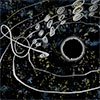| Apr 05, 2022 |
|
|
|
(Nanowerk News) Typical overtone chords in the gravitational waves produced when black holes collide could be used to test general relativity, a mathematical analysis by a RIKEN physicist has shown (Physical Review D, “Ease of excitation of black hole ringing: Quantifying the importance of overtones by the excitation factors”).
|
|
When black holes merge, they generate gravitational waves, which ripple outward like sound waves from a ringing bell. In theory, these gravitational waves can be broken down into tones and overtones—like in music—based on their different frequencies and the rate at which they dampen and die out. But in practice, gravitational-wave detectors are not yet sensitive enough to definitively pick up the overtones.
|
 |
| Figure 1: When two black holes collide and merge, the new bigger black hole rings like a bell, generating gravitational waves that eventually dampen. (Image: RIKEN Interdisciplinary Theoretical and Mathematical Sciences Program)
|
|
However, cosmologists are keen to measure the precise oscillation pattern because it can tell them more about a black hole’s properties. In particular, the mass of the black hole and the rate at which it is spinning can be calculated from the damping rate and frequency.
|
|
“It’s like when you hear an instrument, you can understand if it is a guitar or a piano,” says Naritaka Oshita of the RIKEN Interdisciplinary Theoretical and Mathematical Sciences Program (iTHEMS).
|
|
This is important for better understanding what happens to Einstein’s theory of general relativity in the vicinity of black holes, which remain mysterious. Black holes famously swallow all objects that cross their surface, or event horizon. According to general relativity, these hapless objects are then drawn towards the black hole’s core, or singularity.
|
 |
| Figure 2: Waveform of gravitational wave from a binary black hole merger that eventually leads to the formation of a bigger hole ringing like a struck bell. (Image: RIKEN Interdisciplinary Theoretical and Mathematical Sciences Program)
|
|
But general relativity cannot describe what happens at this singularity, since Einstein’s laws break down there. Importantly, general relativity states that black holes are completely characterized by their mass and the rate at which they spin. They have no other interesting features, or ‘hair’, that could affect the ringing.
|
|
But some physicists have posited that general relativity breaks down before the core, perhaps at the event horizon. In some alternative models, the surface of a black hole could reflect gravitational waves and produce ‘echoes’ of the gravitational-wave signal. These echoes may drastically alter the typical oscillation pattern of black holes.
|
|
“One of the biggest reasons to study black-hole ringing is to test if general relativity is correct,” explains Oshita.
|
|
With this in mind, Oshita analyzed the oscillation pattern predicted by general relativity. Previous studies by other groups had analyzed the gravitational-wave waveforms produced by computer simulations and had empirically found that of the many subtle overtones, the fourth and fifth overtones were dominant. Oshita’s calculations have confirmed this, and they explain mathematically why it arises from Einstein’s theory.
|
|
“If future data collected by gravitational-wave observatories agrees with this prediction, then general relativity will become stronger,” says Oshita.
|




